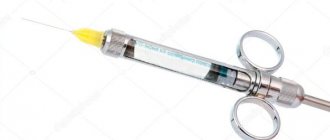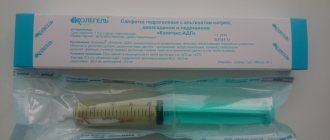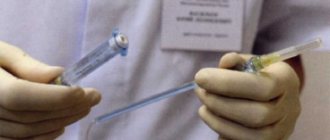Local anesthesia in dentistry: types and preparations
In dentistry, both therapeutic and surgical, different types and techniques of anesthesia are used, for example, conduction, infiltration, intracanal, intraosseous, intraligamentary (intraligamentous), tuberal and others. Their differences lie in the place of application and in some features of their effects. As a rule, modern dental clinics in Moscow use carpule anesthesia. This means that the anesthetic is supplied in disposable carpules - a kind of cartridges with an anesthetic solution that are inserted into syringes with screw-on disposable needles. Due to this, the carpules remain sterile, since the dentist does not have to open them, thereby eliminating contact of the medicine with air.
Conduction anesthesia
Conduction anesthesia is aimed at blocking the nerve through which the pain signal is transmitted. In this way, it is possible to “turn off” a significant area of the jaw associated with the nerve that was exposed to the drug for a fairly long time - from an hour to an hour and a half. As a rule, conduction anesthesia is prescribed if extensive intervention is required on several molars and adjacent soft tissues. With the conduction method, the anesthetic is administered in close proximity to the nerve, and it is very important to correctly calculate this location, since if it is too far from the nerve, pain relief may not occur, and if it gets into the nerve itself, a complication such as neuropathy may develop . According to statistics, neuropathy occurs in 1% of cases and most often completely recedes within a year. By the way, when conducting conduction anesthesia in dentistry under ultrasound guidance, its safety and effectiveness are significantly increased.
Advantages of the method
- The rapid onset of the effect of loss of sensitivity and blocking of nerve impulses.
- It is successfully used during caesarean section or to ease contractions during childbirth. Thanks to the safe effect on the patient’s body, the mother in labor does not have to worry about the health of the baby.
- A much smaller dose of the drug enters the patient’s body compared to other types of anesthesia.
- By using a thin needle when injecting the drug, the risk of internal damage is minimized.
- This anesthesia technique involves the muscles being as relaxed as possible, which greatly helps the surgeon during the operation.
- There is minimal intoxication of the body when the drug is administered, since the percentage of the anesthetic entering the blood is in isolated cases.
- The analgesic effect does not affect the respiratory system; therefore, problems associated with the lungs are automatically excluded, as is the case with general anesthesia.
- The patient remains conscious, which helps to immediately eliminate complications, since direct contact is maintained between doctors and the patient during the entire surgical process.
- Minimal risk of complications after puncture due to the simplicity of the anesthetic injection technique.
Spinal anesthesia has many advantages
Topical anesthesia in dentistry and drugs
Infiltration or application anesthesia in dentistry is carried out by soaking soft tissues with an anesthetic solution, as a result of which the nerve endings located in the treated area are blocked. With topical anesthesia, the anesthetic is applied without the use of a syringe. Using a cotton swab or your fingers, apply a small amount of the product, which subsequently penetrates approximately 3 mm inside and numbs the selected area. In dentistry, it is used to perform simple and quick operations associated with anesthesia of the oral mucosa, since it lasts, on average, from 10 to (in rare cases) 25 minutes. It is often preceded by subsequent injection anesthesia, especially if the patient is a child or is afraid of injections. There are also preparations for topical anesthesia in the form of aerosols. They are not widely used in dentistry due to difficulties in calculating dosage, as well as easy penetration into the respiratory tract and bloodstream, which increases the risk of complications.
Tooth preparation
The technique of local anesthesia during interventions on the pulp rarely depends on the location of the development of the inflammatory process and the level of its progression.
If after the procedure the pain syndrome is eliminated, the doctor begins to act on the hard fragments of the tooth, namely:
- cleans the disease-affected cavity from small particles of food and salivary secretions;
- edge elements are smoothed with boron to improve the aesthetic result;
- opens the working area so that nothing interferes with operational work. If there is a clinical situation where pathology has formed in the proximal area, the cavity is carefully brought to the surface;
- using a medical excavator, soft parts of dentin are removed from the side walls and base of the cavity;
- Use a sharp bur attachment to remove the remaining fragments;
- the finished cavity is treated with an antiseptic, brought to a dry state using cotton swabs and treated with a weak warm air flow.
Having completed all these measures, the dentist decides on the spot which blockade option to prefer - intrapulpal anesthesia or injection anesthesia.
Infiltration anesthesia
This is one of the most common methods of anesthesia in modern dentistry. There are two types of infiltration anesthesia: direct and indirect. Direct anesthesia is injected directly under the mucous membrane near the teeth that require treatment, and acts at the injection site. Indirect spreads to surrounding tissues and covers a larger area, while its prevalence depends on the type of surrounding tissues. For example, on the upper jaw the alveolar process is more porous, while on the lower jaw it is denser, which means that the effect of infiltration anesthesia on the upper jaw will be more effective.
Intraligamentary anesthesia
Intraligamentary anesthesia is also called intraligamentous and intraperiodontal. Its difference is in higher pressure when administering an anesthetic, which ensures uniform spreading of a small amount of the drug in the periodontal space, as well as its penetration into the intraosseous space. Drugs should be administered very slowly. When using this type of anesthesia, significantly less drug is required than with conventional infiltration; it occurs within 15-45 seconds and lasts for 20-30 minutes. For intraligamentary anesthesia, special syringes are often used, which make it possible to administer the drug under the required pressure without unnecessary effort and thus achieve the best result.
Intraosseous anesthesia
Intraosseous anesthesia in dentistry is chosen when infiltration or conduction anesthesia is ineffective. It is usually performed in the area of the lower molars and is indicated for treatment, tooth extraction and operations on the alveolar process. However, it is rarely used due to the complex technique of execution: it is necessary to dissect the mucous membrane, then make a hole in the bone with a special bur with a diameter equal to the size of the syringe needle in order to direct the syringe directly to the spongy substance. The drug should be administered slowly, under high pressure.
Among the advantages of this type of anesthesia is significant efficiency; a small amount of even a weak anesthetic is sufficient. Among the disadvantages are the complexity of implementation, as well as serious risks of complications if the drug enters the bloodstream, which is likely due to accidental damage to a vessel.
Dentists' opinions
A number of specialists with scientific experience and many years of practical activity in the field of surgical dentistry fundamentally do not use the method of relieving pain in the pulp area discussed in this article.
the reason for their negative attitude towards pain relief technology to be the high probability of penetration of pathogenic microorganisms into the inner layers of the affected dental tissues, which enter there during the process of created pressure.
Modern scientific developments consider this theory untenable, and scientists claim that a huge list of the latest disinfectants and antiseptics of the latest generation can provide a full guarantee that the surgical field will be reliably and efficiently disinfected, including the carious cavity.
So the risk of infection and further development of internal inflammatory lesions is reduced to zero.
Which method of influencing the pain syndrome to choose—injection or druk-anesthetic—should be decided taking into account the full clinical picture of the course of the pathological process, the presence of certain contraindications to each specific option.
And if, for medical reasons, the use of a needle is not associated with difficulties and the risk of puncturing the surrounding tissues, it is better to use this technique. It is an order of magnitude more effective and ergonomic for the doctor.
Intracanal anesthesia
The intracanal method of pain relief speaks for itself. Typically, intracanal anesthesia in dentistry is carried out in this way: using a drill, a hole is made in the tooth corresponding to the diameter of the needle, and the drug is injected directly into the pulp or deeper into the canal. Sometimes the carious cavity itself is used for this. If we are talking about the intraligamentary technique, then we mean the introduction of a local anesthetic solution into the space at the root of the tooth (periodontal), and the tuberal technique means the introduction of a substance into the posterior alveolar branches of the upper jaw.
Tuberal anesthesia
Tuberal anesthesia is so named in connection with the injection site - the tubercles of the upper jaw, which are called tuber in Latin. The posterior alveolar nerves are located here, innervating the area of the alveolar ridge from the third to the first molar. This type of anesthesia is the most dangerous in terms of possible complications due to individual differences in the structure of this area and the location of nerves and blood vessels in it. There are intraoral and extraoral methods of administering tuberal anesthesia. It is believed that the intraoral method is more likely to cause injury, while the external method is safer and it is also easier to ensure adequate antiseptic treatment of the surface before injection.
Computer anesthesia
Computer anesthesia allows dentists to calculate more accurate doses of the drug, administer it at the desired speed, pre-selected by the computer, and painlessly guide the syringe needle, which has a special cutting edge. Anesthesia administered with high precision can last longer - up to 40 minutes, and visual and audio signals provided by the device allow the doctor to position the needle as needed, without the risk of tissue damage, introducing anesthetic into the bloodstream or placing the needle too far from the nerve.
Negative consequences of spinal anesthesia
In order for the patient to decide to undergo spinal anesthesia, he needs to familiarize himself in advance with information about the disadvantages of this method of pain relief.
- During the medication administration process, the patient's blood pressure may drop sharply. Therefore, hypotensive patients are given drugs that increase blood pressure in advance - of course, if necessary. For hypertensive patients, this consequence can only have a positive effect.
- The time of loss of sensitivity is directly related to the dose of the drug. If sensitivity returns before the required time, and there is not enough time to complete the operation, the patient is immediately placed under general anesthesia. The spinal anesthesia method does not involve constant support of the anesthetic in the body; most often it is administered once. However, do not worry, since modern medicine uses medications that last up to six hours, which in most cases allows the surgeon to carry out all the manipulations on time.
- Headaches are a frequent companion of the patient after recovery from anesthesia.
Ultrasound anesthesia
When performing anesthesia, it is very important to choose the right injection site, since a mistake can lead to serious complications. This is especially true for conduction anesthesia, where the drug must be in close proximity to the nerve, but the needle cannot touch it. Ultrasound successfully helps determine the site of anesthetic injection. Under the control of an ultrasound machine, it is possible to calculate down to the millimeter the location of the needle and its proximity to the nerve, thereby ensuring the most effective and safe anesthesia of the desired area.
General anesthesia in dentistry
In some cases, the patient may require dental treatment under general anesthesia. As a rule, it is used when serious and long-term treatment is necessary, for example, the removal of several teeth at a time or complex operations on the jaw. An indication for the use of general anesthesia in dentistry may also be serious dental phobia or a disease in which a person cannot adequately communicate with the doctor, or he may have unexpected reactions to the doctor’s actions, as, for example, with epilepsy.
As an alternative to general anesthesia to correct mood and relieve fear of dental treatment, there is sedation in dentistry. It does not “turn off” consciousness, but puts you into half-asleep and calms you down, helps you relax, and perceive what is happening in a positive way. However, sedation is not anesthesia, so it is used in combination with local anesthesia.
Let's sum it up
Spinal anesthesia is an extremely safe method of pain relief. If the patient is faced with a choice between spinal and general anesthesia, then it is worth giving preference to the first - firstly, it does not require long preparation, and secondly, the recovery period after such anesthesia is short and, moreover, quite comfortable. There is no need to be afraid of this type of anesthesia - after a few hours, sensitivity is completely restored, and the patient can forget about any discomfort.
When is anesthesia used in pediatric dentistry?
Most adults have a fear of dental treatment left over from childhood, so today one of the tasks of a pediatric dentist is to prevent the occurrence of dental phobia or get rid of fears that have already formed in the child. General anesthesia is often the only way to solve dental problems in children under three years of age, as well as in children with developmental disabilities, in particular with autism, Down syndrome, cerebral palsy or epilepsy.
It is not always necessary to carry out dental treatment in children under anesthesia. A small patient who comes to a kind and open doctor will be able to perform most of the manipulations while conscious. The main condition is that these manipulations must be painless. According to some studies, today the most painful procedure for a child is the anesthetic injection itself. That is why in pediatric dentistry, before an injection, topical anesthesia is used, the preparations for which have a pleasant taste, which contributes to a good mood in children and their cooperation with the doctor.
In addition, today in dentistry it is no longer uncommon to have a device for computer anesthesia, which allows painless administration of medicine and clearly measuring its correct dosage.
Preventing complications
In order to eliminate the risk of developing negative consequences, it is necessary to strictly follow the recommendations of the anesthesiologist.
- 6-8 hours before surgery, do not eat or drink any liquids.
- Do not smoke tobacco products 6 hours before surgery.
- Do not wear makeup or polish your nails before surgery.
- Remove contact lenses from your eyes and remove all removable dentures, if any, from your mouth. It is necessary to inform the anesthesiologist in advance about the presence of ocular prostheses if they are worn.
- Remove rings from your fingers, earrings from your ears, chains from your neck, as well as other jewelry items. For believers, it is permissible to leave the cross on the body, but not on a chain, but on a braid.
Compliance with these recommendations significantly reduces the risk of complications.
The main thing is that the patient informs the anesthesiologist about all his diseases, previous injuries and surgical interventions, and also talks about the presence of possible allergies to medications or intolerance to any drugs. The specialist also needs to know whether the patient is taking medications. Collecting this information is the key to successful spinal anesthesia. This will also help prevent negative side effects after anesthesia.
Before administering anesthesia, the patient must inform the doctor about previous or existing diseases, taking any medications, injuries and other features
Before the operation, the patient should rest well and get enough sleep. It would be a good idea to spend some time in the fresh air and calm down. These simple steps will help you psychologically tune in to a positive wave, which will greatly facilitate the process of surgical intervention, and will also help the body recover faster after its completion.
Modern anesthesia in dentistry: contraindications for use
The main contraindication to anesthesia in dentistry is an allergy to its components; side effects should also be taken into account, which are most often associated with the presence of additional substances in the anesthetic solution: vasoconstrictors, preservatives and stabilizers. In particular, it is necessary to especially carefully select drugs for patients with cardiovascular diseases, arterial hypertension, and decompensated forms of endocrine diseases (diabetes mellitus, thyrotoxicosis, and others). To determine which substances a person has a negative reaction to, the doctor sends him to the Institute of Allergology to perform tests. In accordance with these data, a safe drug for local anesthesia is selected, and in case of reaction to all groups of anesthetics, general anesthesia is used.
Reviews
This method of pain relief in the treatment of dental diseases, associated with a high sensitivity threshold of the pulp, not only completely neutralizes the impulse for the required period of time, but also has virtually no side effects. The only complication is pain.
If you are interested in the intrapulpal technology of anesthetic administration, you can leave your comment in the appropriate section. Perhaps it is your opinion that will help someone overcome doubts and fears before visiting the dentist.
If you find an error, please select a piece of text and press Ctrl+Enter.
Tags anesthesia pulpitis
Did you like the article? stay tuned
Previous article
When is the use of the Persin apparatus for the correction of malocclusions justified?
Next article
Innovative dental restoration using Gradia Direct filling
What are the features of anesthesia in dentistry for pregnant women?
It is also important for pregnant women to ensure pain-free dental treatment. However, conventional painkillers are not suitable for them, since vasoconstrictors (also known as vasoconstrictors) are usually added to the anesthetic solution in order to keep it in the right place and prolong its effect. Vasoconstrictors also reduce potential common side effects and reduce bleeding. For example, adrenaline added to a four percent solution of articaine can extend its analgesic effect from three to forty-five minutes.
Only mepivacaine can be used without adrenaline, since, unlike other drugs for local anesthesia used in dentistry (articaine, which is considered the best option today, novocaine and lidocaine), it does not have the ability to dilate blood vessels at the injection site, which means it can be recommended for pregnant women, children, and other categories of patients who should not be administered adrenaline. These include, for example, those suffering from cardiovascular diseases, arterial hypertension, severe forms of diabetes mellitus, and severe thyrotoxicosis.
Anesthetics for anesthesia
For spinal anesthesia, agents with various properties are used. Each of these drugs gives a different effect in terms of duration of exposure. Patients with allergic diseases should not worry: there are a lot of options for administered medications, and the doctor will definitely replace a drug that is unsuitable for the individual body with one with a similar effect. Here are some of the medications that are used for spinal anesthesia: Narolin, Novocaine, Mezaton, Fraxiparine, Lidocaine, Bupivacaine and many others.
"Mezaton"
For your information, the table below shows the active ingredients used in spinal anesthesia drugs, their dosages and the duration of action of each of them. Thanks to this table, the patient can determine whether he is allergic to a particular drug and whether the dosage is appropriate for him.
| Medicine | Concentration of solutions, (%) | Maximum dose, (mg) | Duration of action (minutes) |
| Procaine hydrochloride | 0.25 or 0.5 | 500 | 40-60 |
| Lidocaine | 2-5 (hyperbaric solution) | 15-100 | 60-90 |
| Tetracaine hydrochloride | 0.5 (hypobaric, isobaric or hyperbaric solution) | 5-20 | from 180 (hyperbaric solution) to 270 (hypobaric solution) |
| Bupivacaine hydrochloride | 0.5 (isobaric or hyperbaric solution | 10-20 | 90-150 |
| Artikain | 5 (hyperbaric solution) | 100-150 | up to 120 |










